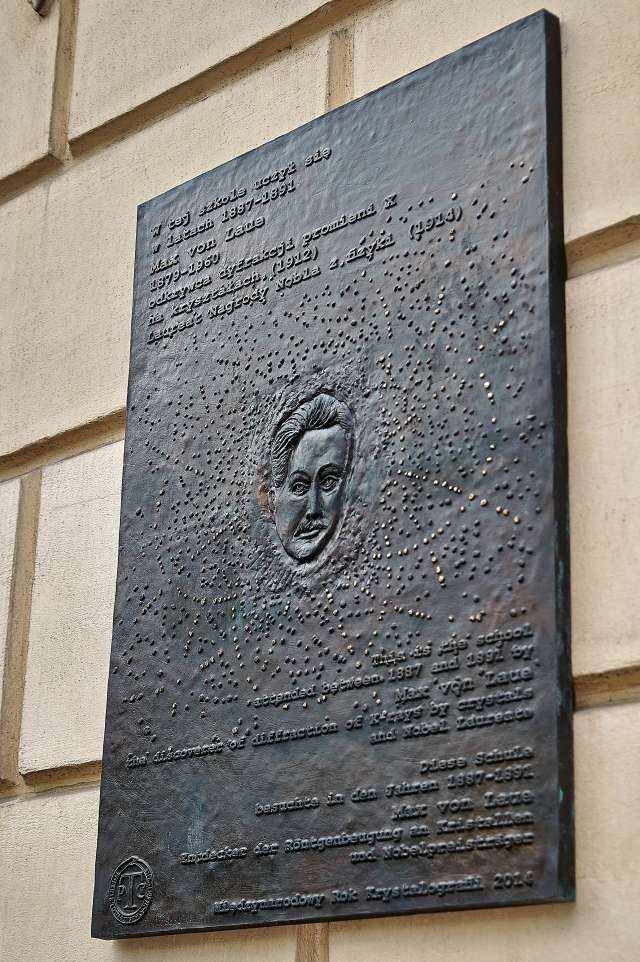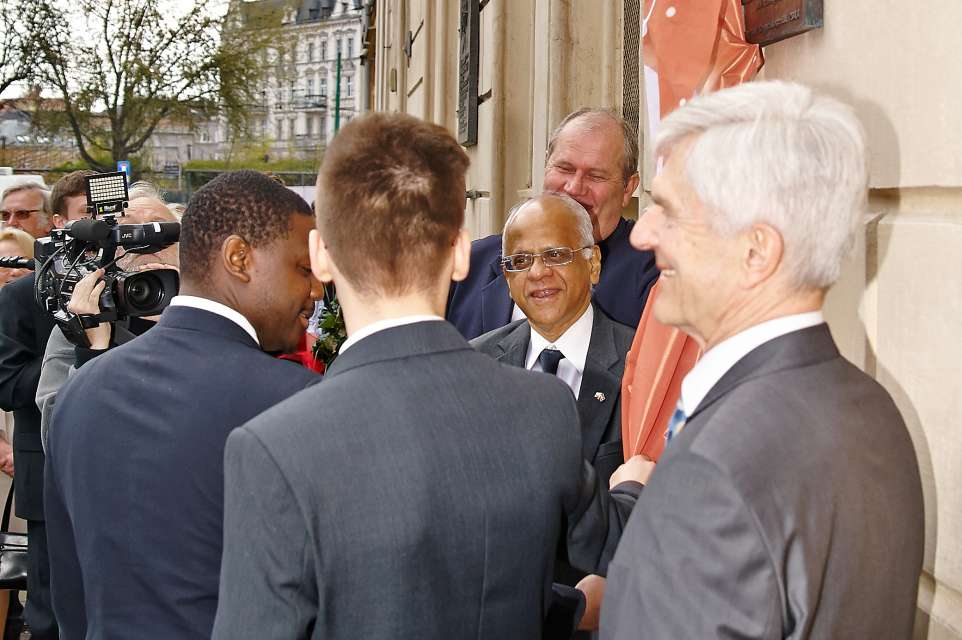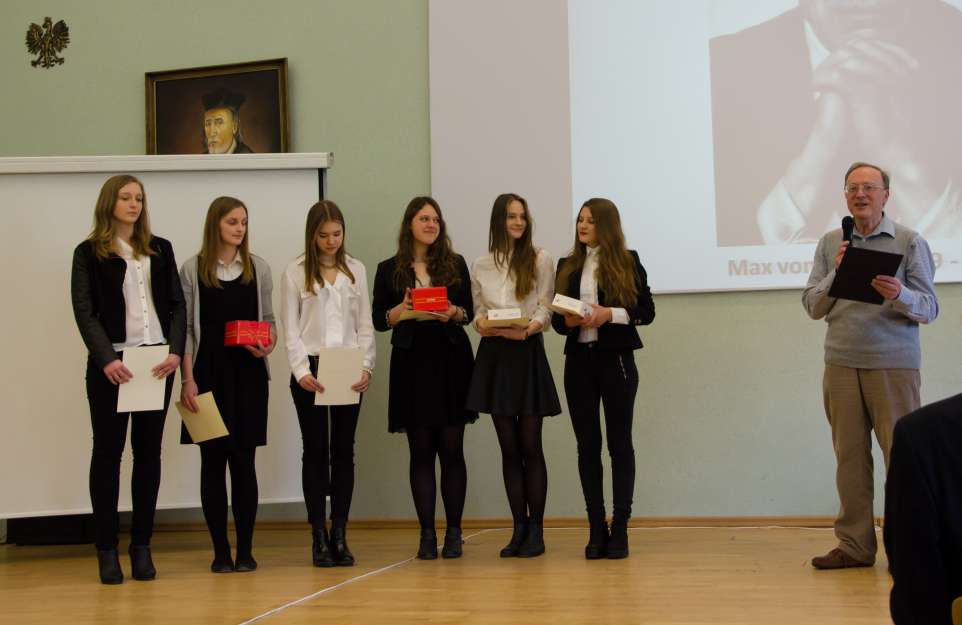 |
| Fig. 1. The Laue Memorial Plate (author: R. Sobociński). (Photo G. Dutkiewicz.) |
Laue Memorial Plate dedicated in Poznań to celebrate the International Year of Crystallography 2014
In the years 1887-1891, Max von Laue (1879-1960) attended Friedrich-Wilhelms-Gymnasium, now St. John’s Senior High School No. III (III LO im. św. Jana Kantego) in Poznań. About 20 years later, working at Ludwig-Maximilians-Universität München, Max von Laue conceived of an X-ray diffraction experiment with a crystal as a three-dimensional diffraction grating. Such an experiment was successfully conducted under Laue’s instructions by Walter Friedrich and Paul Knipping in 1912. Its outcome is counted among the greatest discoveries of science, equal in importance to the discovery of the double helix of DNA about 40 years later (also with the use of X-ray diffraction). Laue’s discovery had immediate implications in physics (and won him the 1914 Nobel Prize in Physics): it provided evidence about the wave nature of X-rays; proved the periodic lattice structure of crystals; and provided an estimate of the interatomic distances (i.e. of chemical bond lengths) in molecules, which had to be of the same order as the X-ray wavelength, about 1 ångström. The discovery, in the hands of William Henry Bragg and William Lawrence Bragg (Nobel Prize in Physics, 1915) was soon converted into a powerful tool for the determination of the structure of chemical molecules. Today, the precise 3D structure of nearly one million chemical compounds is known, in this number ~100,000 structures of the molecules of life, including true molecular giants, such as the ribosome.
 |
 |
| Fig. 2. The unveiling act performed by (right-to-left) Jacek Gawroński (Polish Chemical Society), Gautam Desiraju (IUCr), Andreas Roodt (ECA), Norbert Jędrzejczak (school student, only back visible), Jean-Paul Ngome-Abiaga (UNESCO). (Photo G. Dutkiewicz.) | Fig. 3. Poster prizes, sponsored by the Polish Synchrotron Radiation Society, announced by the chair of the poster jury, Alexander Wlodawer. The winners, right-to-left: Wiktoria Palczewska and Agata Cieślak (1st Prize), Adrianna Jarczyńska and Oliwia Degórska (2nd Prize), Diana Król and Natalia Pietruch (3rd Prize). (Photo M. Ruszkowski.) |
As part of the celebration of the International Year of Crystallography IYCr2014, a Committee was established in Poznań, Poland, with the goal of commemorating Laue and his time in Poznań with a special Memorial Plate. The Committee included Prof. Mariusz Jaskolski (chair, Center for Biocrystallographic Research), Prof. Wulf Depmeier (Deutsche Gesellschaft für Kristallographie and IUCr Executive Committee), Ms Ewelina Framska (chemistry teacher), Prof. Maria Gdaniec (Committee of Crystallography, Pol. Acad. Sci.), Ms. Katarzyna Kordus (the Schoolmaster), Prof. Henryk Koroniak (Dean, Faculty of Chemistry, A. Mickiewicz University), Prof. Andrzej Legocki (Institute of Bioorganic Chemistry, Pol. Acad. Sci.), Prof. Andrzej Sakson (Association of School’s Alumni) and Prof. Wojciech Kwiatek (treasurer, Polish Synchrotron Radiation Society). The Plate, founded by the Polish Chemical Society and executed by a renowned sculptor, Robert Sobociński, was unveiled on the School building on April 11, 2014. The dedication ceremony was attended by Mr Jean-Paul Ngome-Abiaga (UNESCO), Mr. Joachim Bleicker (Charge d’Affaires of the German Embassy), Prof. Gautam Desiraju (IUCr), Prof. Andreas Roodt (ECA) and representatives of the local government. It was followed by a Symposium, which showed Laue as a scientist, a champion of freedom, and his legacy as source of inspiration for others. The lectures were presented by Prof. Andrzej Więckowski, Prof. Wolfgang Schmahl, Prof. Janusz Lipkowski, Prof. Wojciech Rypniewski, Dr. Alexander Wlodawer, Prof. Jerzy Pełka, Prof. Udo Heinemann, Dr. Agnieszka Kiliszek and Prof. Dieter Hoffmann. The School auditorium was full with more than 200 participants, including many pupils and students. The School students presented a poster session dedicated to Max von Laue and various aspects of his discovery. The best poster, by Agata Cieślak and Wiktoria Palczewska, was awarded with a prize generously sponsored by the Polish Synchrotron Radiation Society. There were several other sponsors of this function, including the Ministry of Science and Higher Education, IUCr and ECA.
The integrative ideals of this special Laue Day, when scientists, school pupils, dignitaries and ordinary people from a number of countries met in a secondary school somewhere in Poland, were beautifully summarized by Prof. Desiraju: "Science is truly a way of bringing nations together and I join the community of crystallographers of Poland and Germany to celebrate the subject of crystallography and to honor the memory of one of our greatest sons."
 |
| Fig. 4. The Laue Plate veiled with the IYCr2014 banner. (Photo G. Dutkiewicz.) |
There was also a concert of choral music, performed by the School Choir "Proscenium" (conductor Jacek Zając) and by Poznań Chamber Choir (conductor Bartosz Michałowski). As part of the program, the School opened a Science Museum, with a collection of many original documents connected with Max von Laue and other memorabilia. The busy Laue Day was concluded with a Laue Dinner, at which many toasts were proposed to the bright future of crystallography and to ideas, like this one, that have the power to bring people together, and make any barriers, divisions or borders - irrelevant.
Prof. Mariusz JaskolskiChair of the Laue Plaque Committee
Poznań, Poland


